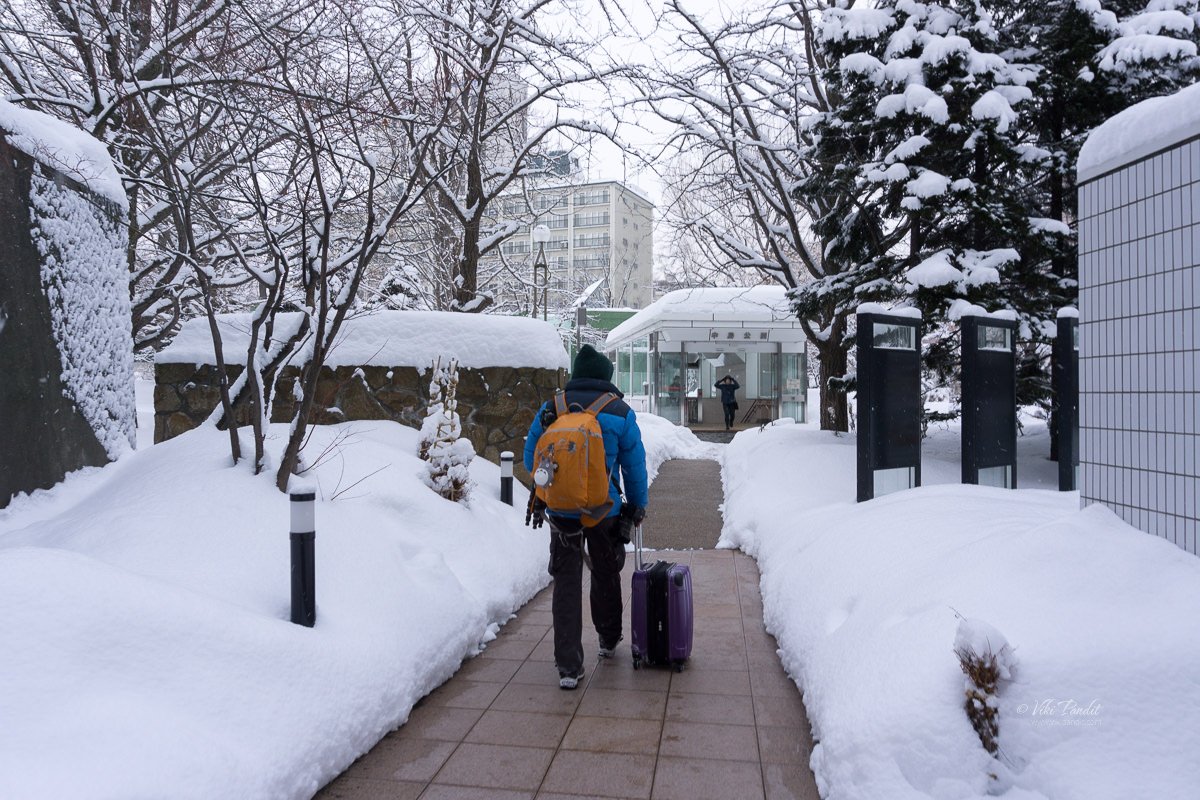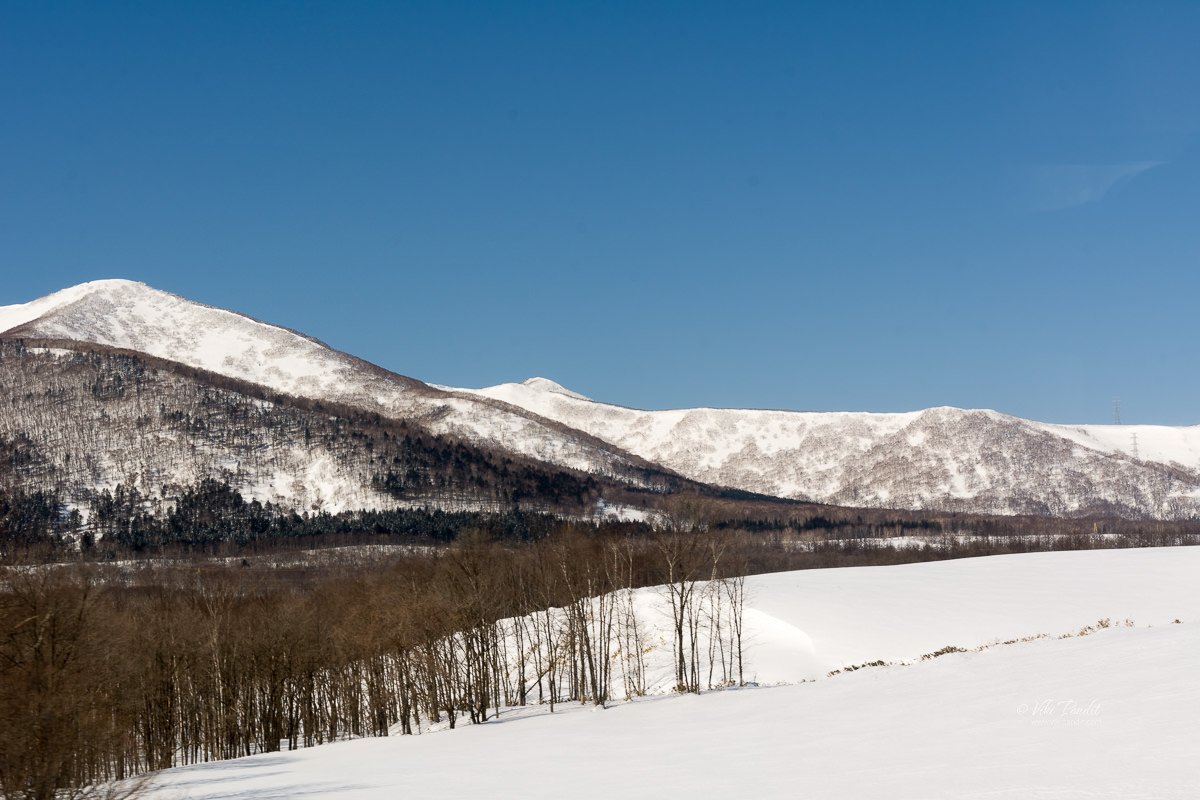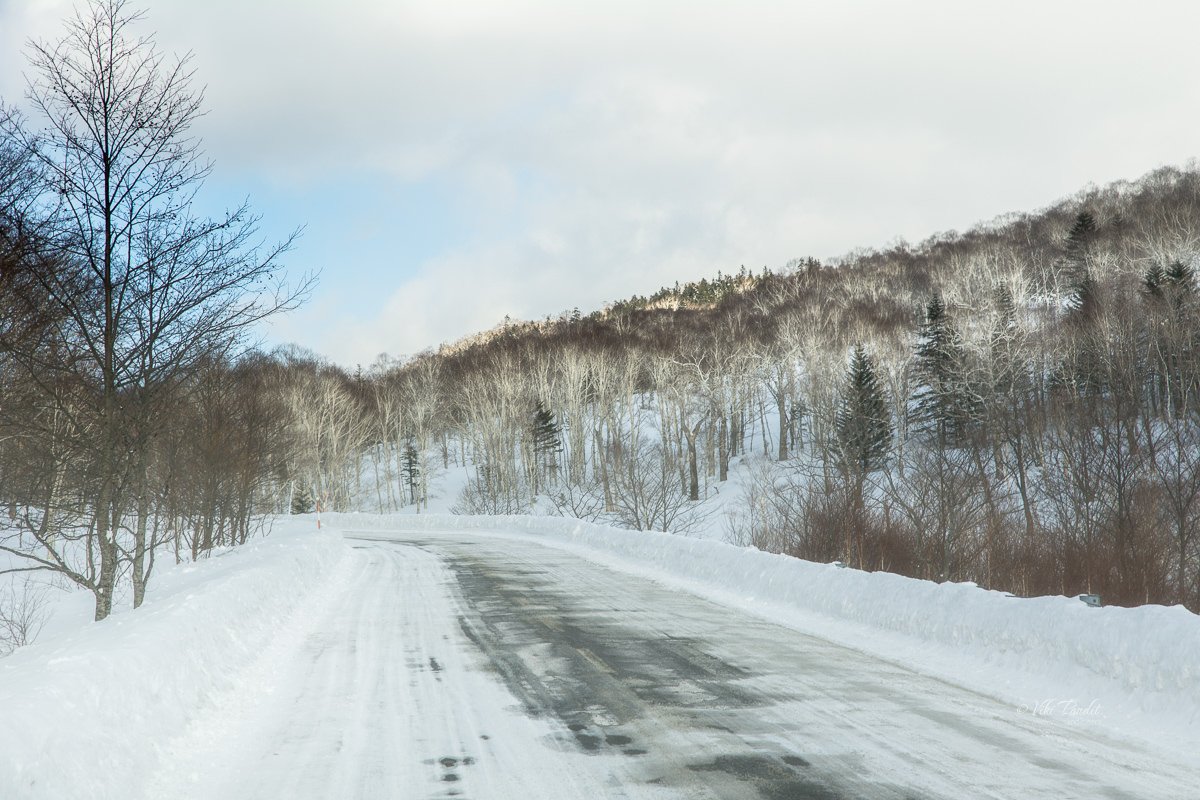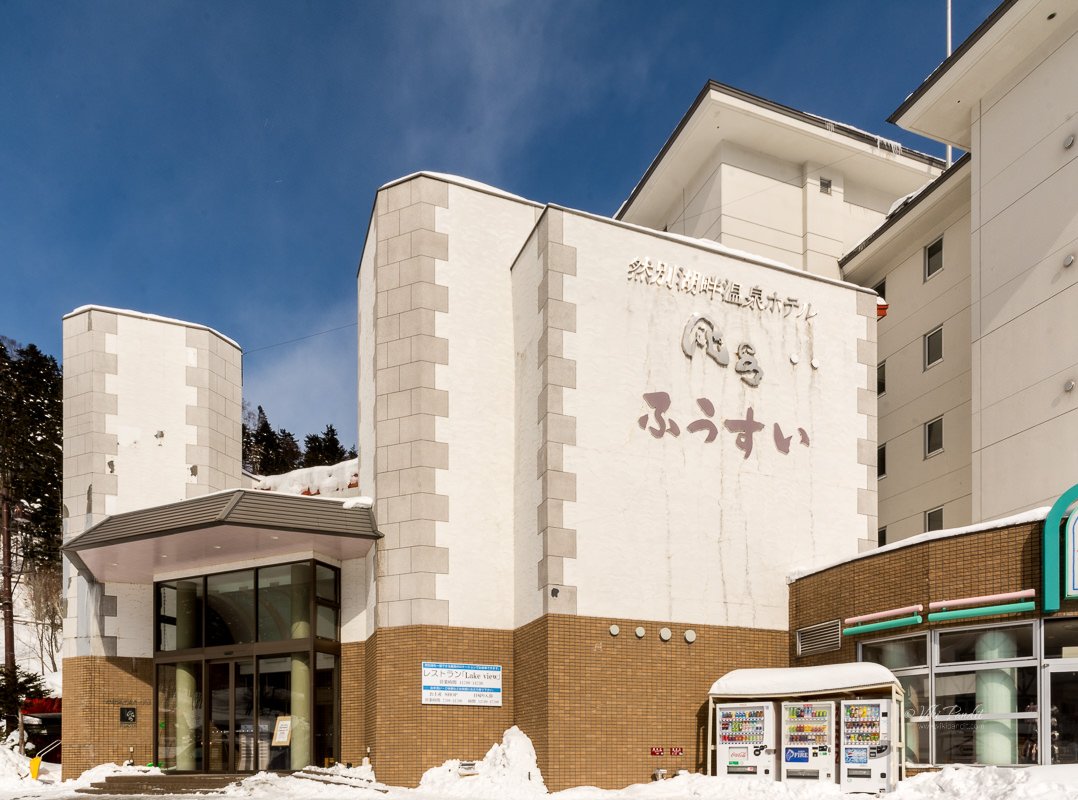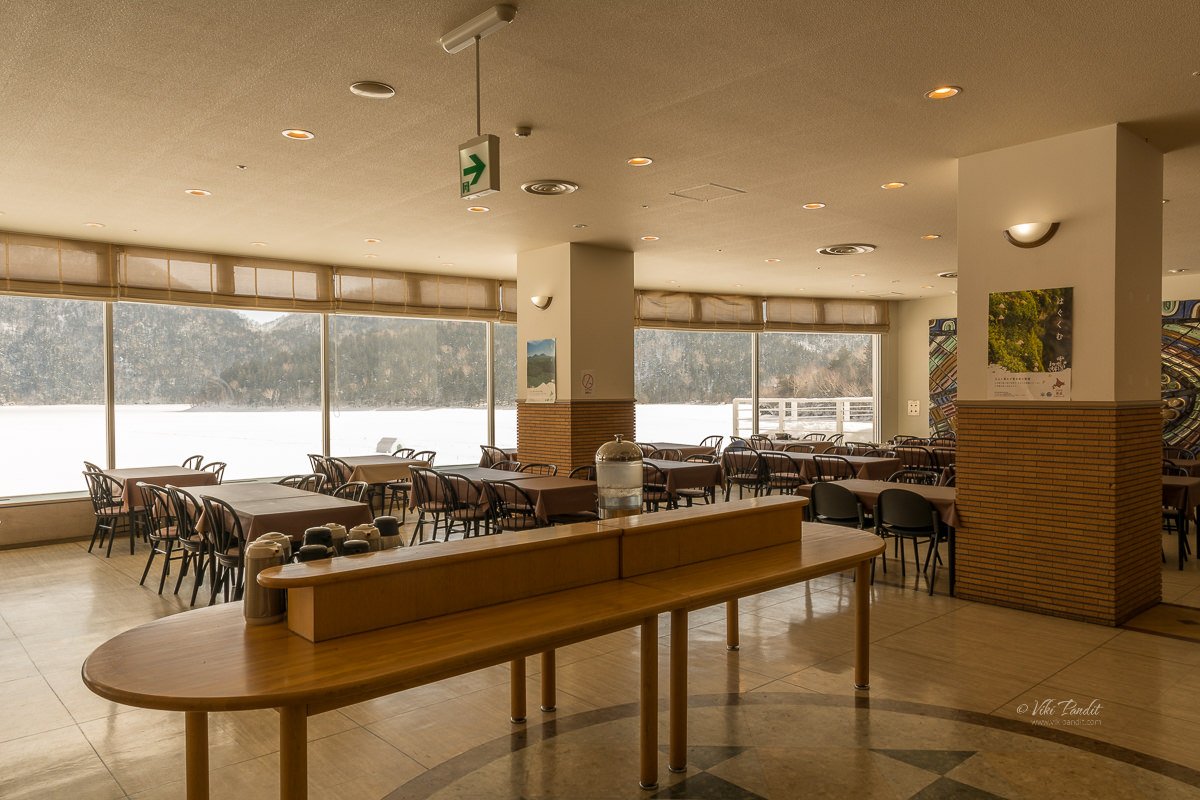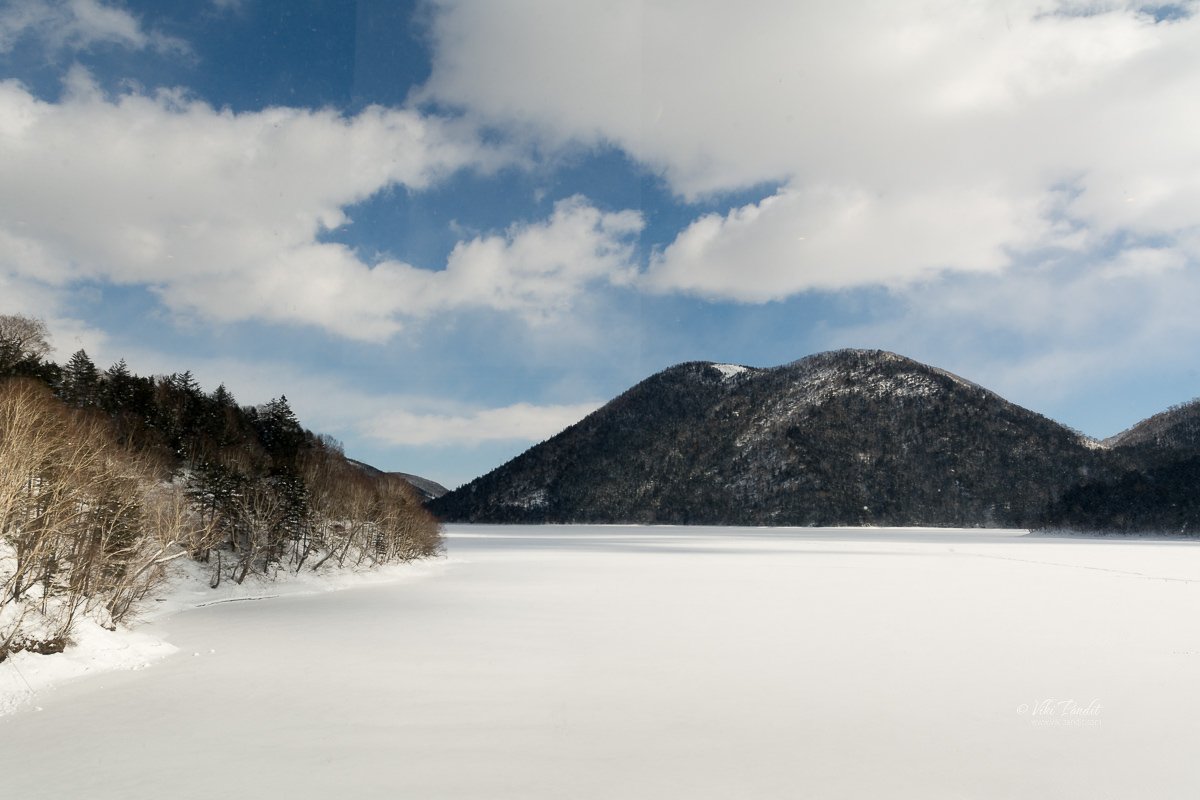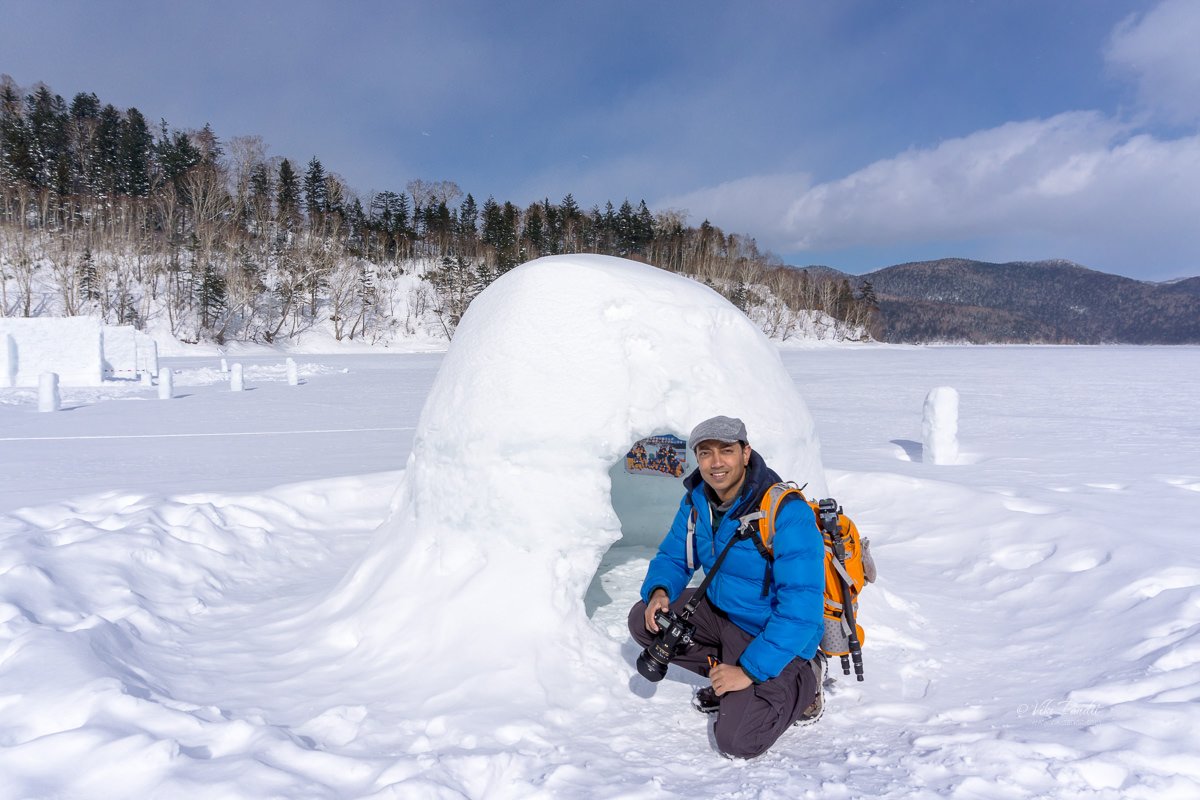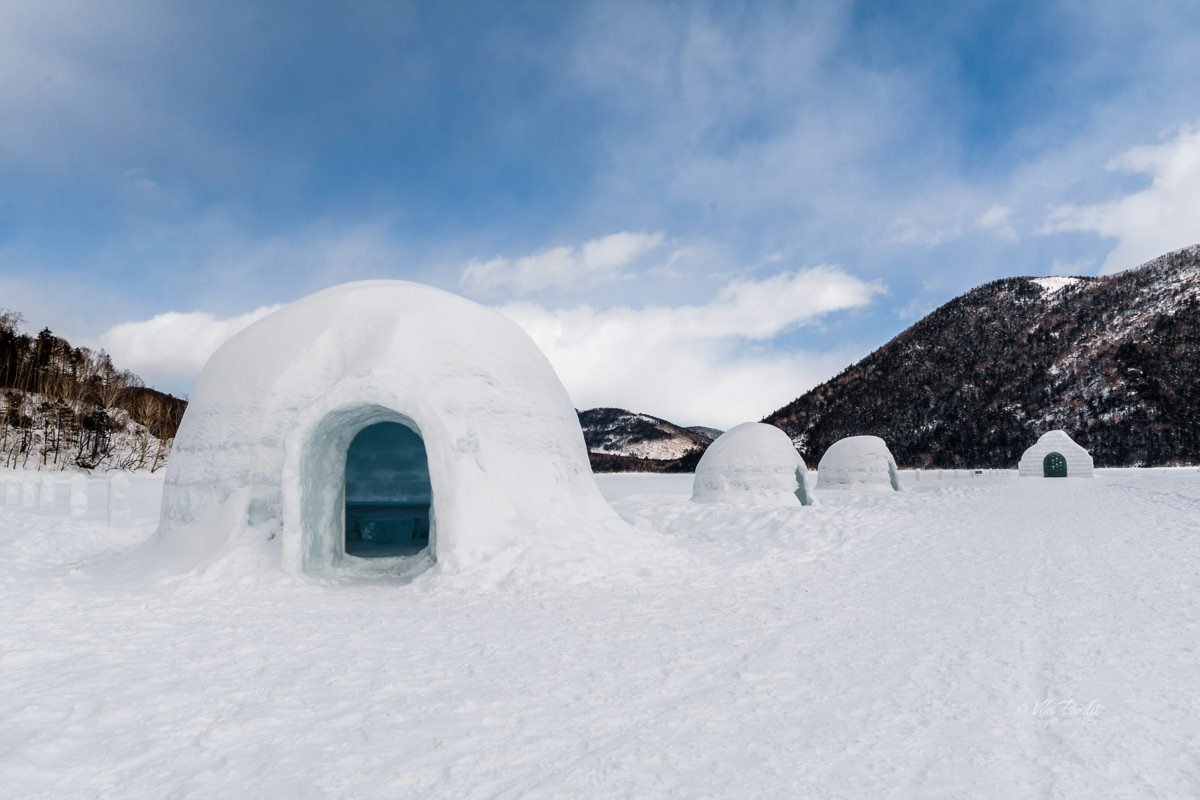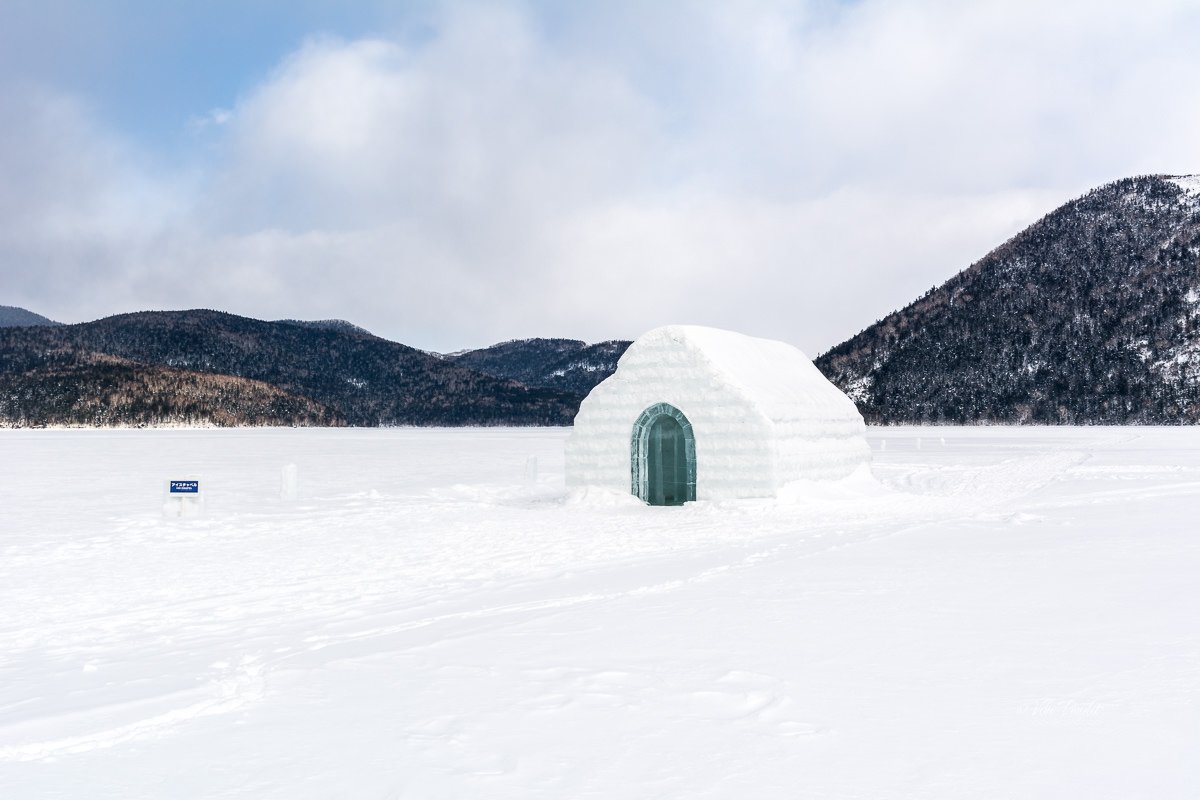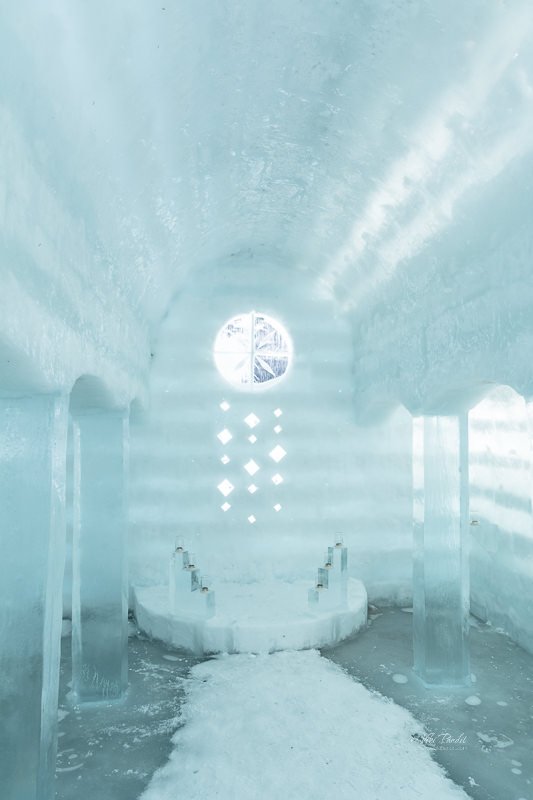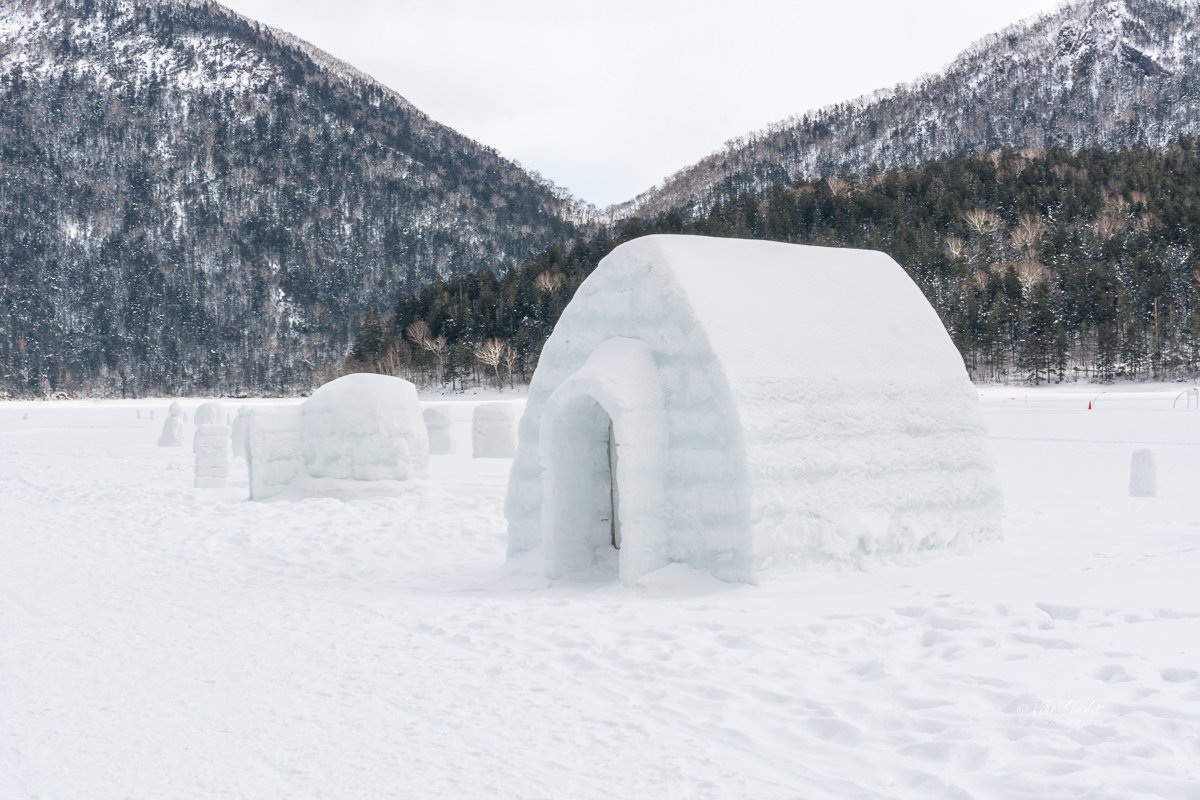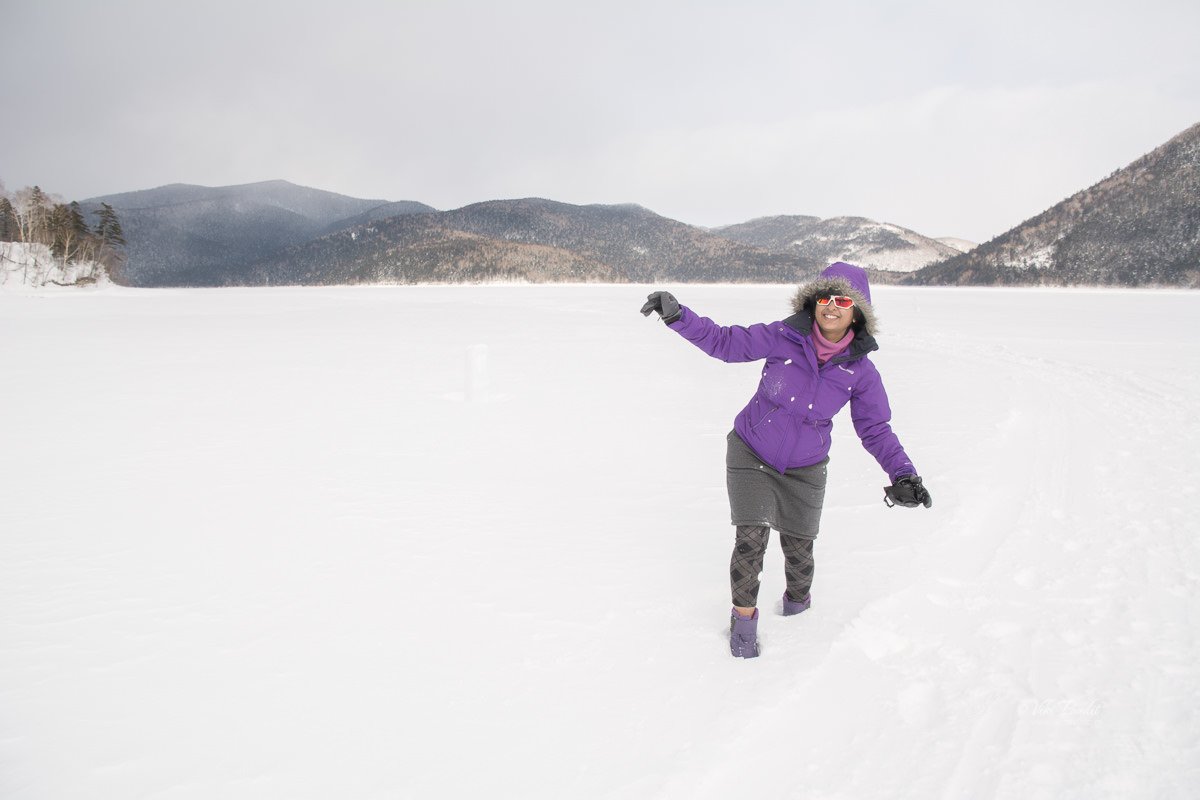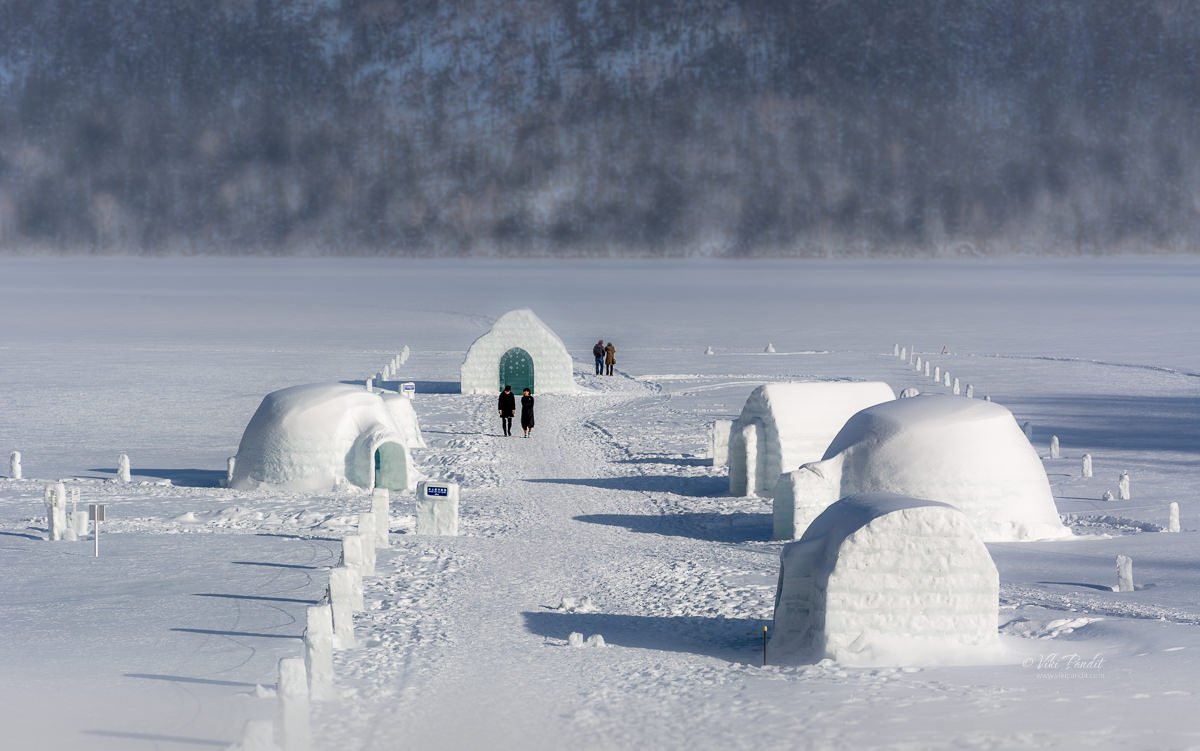Our first day on the beautiful island of Hokkaido. I was excited and looking forward to spending my next week surrounded by snow. Coming from a land where temperatures frequently touch 50° Centigrade, it is like a fantasy coming to Hokkaido in winter.
It was going to be a long day. We were headed for the city of Kushiro, almost 300 km away. On the way, we had planned to take a break at Obihiro, and visit the phantom ice village on Lake Shikaribetsu.
Phantom?? Because nobody actually lives in that village. Shikaribetsuko Kotan (然別湖コタン) is a winter event held from late January to mid-March at Lake Shikaribetsu, located in the northwestern part of Obihiro. The lake freezes in winter and the people from the nearby village build igloos on the lake using ice creating an experience of an Eskimo village. The kotan (village) exists only during the winter months and melts away with the onset of spring.
Kotan means village or settlement in the Ainu language. The Ainu are the indigenous people who live in the northern regions of Japan, especially Hokkaido.
Sapporo to Lake Shikaribetsu
We had already purchased our special JR Hokkaido passes the day before, which were valid for unlimited travel in Hokkaido for the next 7 consecutive days.
The 7 day JR Hokkaido Pass costs ¥26000 and can be bought at the JR ticket counter at Chitose Airport
We left the warm comforts of our hotel at 7 am and walked down to the Nakajimakoen park. In daylight, the park looked lovely, covered in snow. The snow had tapered down from the previous night and it was relatively easier to walk. Curiously, even though I was surrounded by snow almost 3 ft high, it didn’t feel very cold. Maybe I was just very well protected.
From the park, an underground passage directly connects with the Nakajimakoen Station. From there it is just a couple of stops to Sapporo Station.
At Sapporo, we had a light breakfast. The Station is huge with dedicated rows of shops for clothes, food, and other stuff. We caught the 8.45 am Super Ozora train to Obihiro. For the next 2 hours, I was treated to some breathtaking scenery as the train chugged along the pure white landscape. I have never seen so much snow in my life. It was like the color green had been banished from the lands.
How to get to lake Shikaribetsu – Fusui Bus
We reached Obihiro at 10.40 am. At the station, we went directly to the tourist information center to obtain local bus schedules for Lake Shikaribetsu. The easiest and cheapest way to reach Lake Shikaribetsu is using the Fusui bus. The lady at the help desk informed us, one was leaving within 15 minutes at 11 o’clock. We literally ran to the bus stand since the bus intervals were far apart and it takes almost an hour and a half to reach the lake.
The bus was about half full and mostly filled with locals. It was a pleasant surprise for us when the driver told us that the ride to Lake Shikaribetsu was absolutely free for tourists going all the way to the Lake. However please note there are only 4 runs a day for the free bus.
As we drove across the city, it was clear that it had been snowing heavily for some time. The sidewalks were covered in huge mounds of snow. The roads had been swept of ice but they were still wet and cold steam was rising from the surface. The bus stopped at a few local stops before we left behind the little town of Shikaoi at the foot of the mountain and entered the forested area of Daisetsu National Park.
Daisetsuzan (大雪山) is Hokkaido’s largest national park. The vast mountainous area of unspoiled wilderness is larger than even some of Japan’s smaller prefectures.
Lake Shikaribetsu
The history of the phantom village of Lake Shikaribetsu goes back to 1980 when local residents began building igloos on top of the frozen lake for fun near the Shikaribetsu Kohan Onsen resort. They continued this yearly activity and as the news spread, people from all over Japan began coming to see the ice village during winter.
We reached the lake area at about 1.00 pm. Though the distance from Obihiro is a bit above 60 km, the driver took his time as the bus goes through many elevated sharp curves and snow-covered roads.
Even in this tough terrain, it feels great to see the buses and trains are so particular with time.
The bus dropped us off in front of Hotel Fusui. If you are planning to go back to Obihiro on the same bus, do not forget to collect the free return ride ticket at the reception of the hotel.
Hotel Fusui is located right on the edge of Lake Shikaribetsu. We obtained our return tickets and left our luggage in the care of the reception staff.
We were famished after the long ride, so we went into the restaurant on the ground floor. The restaurant seating is cleverly arranged so the guests can enjoy their meal, simultaneously basking in the breathtaking view of the lake. Recommended by the waiter, we ordered a local delicacy, cooked with the Dolly Varden trout, that is found in the Lake Shikaribetsu itself.
It was quite soothing sitting by the window in the soft sun, overlooking the huge, frozen lake. From time to time, clouds would pass by casting a moving shadow over the frozen lake.
Beside the restaurant, there is a souvenir shop selling locally made wooden artifacts and souvenirs. I made a mental note to come back for some souvenir shopping before boarding the bus back to Obihiro.
After lunch, we walked over to the lake. The place was very serene and peaceful. Far away, on the surrounding mountains, the spruce forests were draped in snow. The elevated landscape in a way cuts of the surrounding area making us feel as we were now on top of the world cut off from everything. Incidentally in the Ainu language, the name of the lake also means “Lake of the Sky.” I would completely agree.
At At 810 meters, Shikaribetsu has the distinction of being the highest altitude lake in Hokkaido
Lake Shikaribetsu Igloo Village
The construction of the ice village begins every year in early January when the ice above the lake reaches a thickness of about 15 centimeters. Local villagers and volunteers from across Hokkaido assemble and work for about three weeks to create this amazing village.
Apart from the scattered igloos, the ice village also features an ice cafe/bar, an open-air bath, and even a chapel – made entirely of ice. As we walked down to the village, the first ice structure we came across was the ice bar. We didn’t bother to go inside as neither of us was thirsty for a drink in the chilling cold.
Once in the center of the village, we spent some time admiring the igloos in this remote Hokkaido village. I kind of took a liking to this one 🙂 It was not very well made but it was kind of private and cozy.
As we ventured to the other structures, it was clear that the construction of these igloos was not amateur by any means. They were thoughtfully designed so one can also stay overnight in these igloos if they choose to. Although do note, the temperatures can get as low as minus 20 or 30 degrees centigrade at night.
Some of the larger igloos have seating arrangements made from blocks of ice. The space was good enough for a small group of 5-6 people. Contrary to what I thought, the igloos didn’t feel as cold as I had imagined they would.
On the northwest side of the village, one can find an open-air hot spring. The hot tub is installed in the water during spring. Once the lake freezes, the tub is no more visible, and with the surrounding snow and ice, it appears as though visitors are bathing in ice. What more can one ask for while bathing in warm spring water, surrounded by snow, mountains, and fresh air. It is a private area, guarded by walls and it didn’t seem decent to capture photos of the onsen with people. You have to come and see it for yourself 😉.
At the far end of the village lies an ice Chapel. The chapel looks like just another igloo from outside. But the inside was beautifully crafted. It must have taken great effort to build something so spectacular just out of ice.
The design of the intricately detailed chapel changes each year and if you check the old photos, the results are always no less than spectacular. From what I hear, many real ceremonies are also held here each year at the chapel.
After coming out of the Chapel, we explored a few more igloos. With clouds gathering, the weather had somewhat become gray by this time.
After investigating the village we wandered off to the far right where a gentleman was offering snowmobile rides. Those looking for a taste of adventure can ride the snowmobile along a pre-designed course over the lake for ¥1000. Neither of us had any experience of handling a snowmobile so the guide drove us across the lake. The guided tour costs ¥2000. In spite of the covered helmets, I could feel the bite of the freezing wind across my face as we drove across the huge lake.
After the cross-lake ride, we loitered around as we still had some time before our 4.10 pm ride back to Obihiro. We walked along a marked trail in the snow. We probably walked all the way to the center of the lake. Looking back, the hotel seemed pretty far.
The farther we walked, the more I realized, the vastness of the lake. With not a soul around, walking over the frozen lake is very refreshing. At some places, we would be almost knee-deep in the snow.
At about 3 pm it had begun to snow again over the mountains and we could no longer make out the summit of the mountains in the heavy snowfall. The snowfall was advancing towards us, fast and within a few minutes, the flakes were falling on us. It had started to feel bitterly cold, so we headed back to the refuge of the hotel.
Back at the hotel, we collected our luggage and relaxed on the couch in the lounge. The storm had subsided when the bus arrived at 4 pm. I could see the sun spreading its long shadows over the ice village. We reluctantly boarded the bus and were on our way back to Obihiro. I desperately wanted to stay back to experience one night at this mesmerizing lake.
It was almost 6 pm by the time we reach Obihiro Station. On the way I noticed, the winds had picked up speed. Accompanied by the snowing, it was already erasing all tracks created by vehicles on the road.
We caught the Super Ozora at 7 pm for Kushiro. It was going to be another hour and a half on the train. I mostly slept through the length of the ride. We reached Kushiro at 8.32 pm. The Kushiro Prince hotel was a couple of blocks away and we walked to it. I still have to get accustomed to the way the roads get so deserted in these parts. People in these northern regions sure shut down early.
We were also tired from all the walking, so right after checking in, we had a quick dinner and went to bed.
Lake Shikaribetsu igloo village was a memorable part of our trip to Japan. Spring will be here in a few weeks’ time and the village, like an ephemeral dream, will gradually melt away into the lake, but the beautiful moments I spent there and its surrounding mountains will forever be etched in my memory.
Thanks for reading. I would love it if you could take a moment and leave me a comment on my story. If you have any questions, don’t hesitate to ask. Tomorrow we go on a tour of Akan National Park arranged by Akan bus.
There are 4 buses scheduled every day for Lake Shikaribetsu from Obihiro Station. The timings are:
7:52 | 11:00 | 14:50 | 16:00
Obihiro Station Bus Terminal 4 Bus Stop
It takes about 1 hour 40 minutes by bus
Between February to mid March
